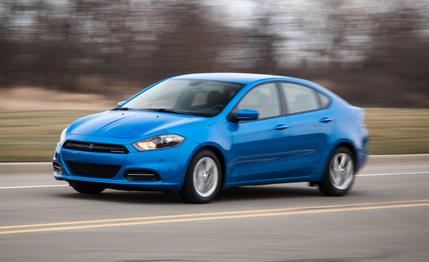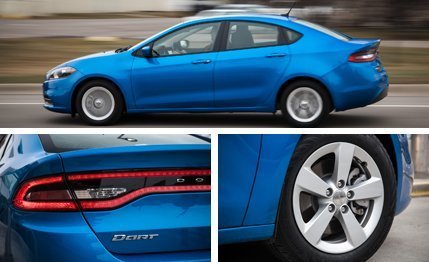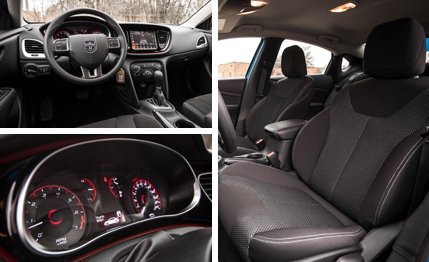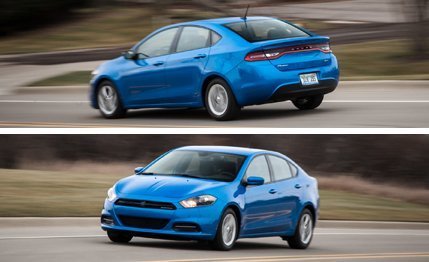
 Instrumented Test
Instrumented Test
We had high hopes for the new Dart when it was rolled out during the 2012 Detroit auto show. Nearly 40 years after the last of the original Dodge Darts aimed for the bull’s-eye, the new Dart emerged with a similar mission to combine basic transportation with all the current amenities in an affordable package.
Dull as that may sound, vehicles that successfully do so earn respect around here, especially if they mix in a heavy dose of fun. (Think Honda Accord Sport.) Unfortunately, our initial enthusiasm for the Dart was tempered with the arrival of our long-term 2013 model; the chassis showed promise during that test, but we came away disappointed, mostly in the powertrain. With our long-termer’s 1.4-liter turbo four now relegated to the efficiency-focused Dart Aero, we thought the time was right to check in with the volume engine, the 2.4-liter four-cylinder with an automatic transmission.
Our test car arrived wearing a fetching shade of Laser Blue Pearl paint, which accented its fluid lines and attractive profile. Being very similar to the exterior finish of the last Chrysler 200 we tested, the hue further emphasized the aesthetic similarities between the two cars that make the Dart look like a small 200. Or the 200 like a big Dart, if you’re on the other side of the showroom.


The 2.4-liter four springs to life with an adenoidal exhaust note. The tone improves with rpm, but burdened by the Dart’s 3244 pounds of mass, it’s fighting an uphill battle. Still, with 184 horsepower and 174 lb-ft of torque on tap, our naturally aspirated test vehicle easily (and exactly) matched the 8.2- and 16.2-second zero-to-60 and quarter-mile times of an earlier Dart we tested with the 1.4-liter turbo and a manual transmission. It was also nice to not have to wait for a turbo to spin up—and to forego the lumpy surges of the 1.4-liter engine.
Yet the 2.4’s acceleration is simply average compared to the rest of the class, with the similarly priced Mazda 3 sedan equipped with an automatic transmission completing the tasks in 7.6 and 15.9 seconds. And gunning for the horizon feels like much more of a chore in the Dart. At least the six-speed automatic transmission capably handles its duties, allowing the engine to run to redline before upshifting and generally being in the right gear while tooling around town.
The Dart’s electric power steering is linear and has a discernible center valley that ensures straight tracking on the highway, which we like, and the chassis—with struts up front and a multilink setup out back—can soak up all but the most severe road imperfections. Combined with the quiet and well-insulated cabin—we measured only 69 decibels at 70 mph, same as the 2015 Mercedes-Benz C300—highway miles evaporated in near silence.


But the good vibes get derailed when the road gets twisty, as body lean and mild understeer make their presence known. Wearing 205/55-16 Continental ContiProContact tires, the car managed only 0.83 g on our 300-foot-diameter skidpad, with our test driver noting heavy intervention from the electronic stability control (which cannot be turned off). A product of the mechanical and cultural crosspollination between Fiat and Chrysler, the Dart’s Compact U.S. Wide (CUSW) chassis is competent but not as engaging as those in truly great compacts such as the Mazda 3 and the Ford Focus.
Inside our car, basic black covered every surface save for the off-white pillars and headliner. It’s a simple theme—and an effective way of pinching pennies. The manual seats are substantially padded and easy to adjust, and they give the interior a whiff of sturdy, full-size-American-sedan essence. The fit of the interior pieces seems to have improved over that of early Darts, but some plastics still feel about a generation and a half behind those of other makers in the same segment. Chrysler’s ubiquitous Uconnect system is a familiar friend, but the gauges (tachometer, speedometer, fuel, and temperature) in the instrument panel look chintzy, and the pixelized, low-res screen between the dials is pure Atari.


The SXT trim level of our car places it above the basic SE (and its wheezy 2.0-liter four) and below the Aero, Limited, and GT models. In addition to the automatic headlights, 16-inch aluminum wheels, and black grille crosshairs that come standard on the SXT, our car had the Cold Weather Group (remote start, heated seats, heated power mirrors), which is a steal at $395. Additional options included the 8.4-inch Uconnect Touch Screen group (the screen, a backup camera, glove-box lamp, remote USB port, iPod control, and an illuminated instrument surround) for an equally reasonable $595; full audio and navigation capability for $495; one year of SiriusXM for $195; and a $350 compact spare. Subbing in the six-speed automatic for a six-speed manual transmission runs a hearty $1250 and brought the total to $23,070.
At that price point, the market is flush with options. If you value sleek styling, a quiet comfortable ride, and a logical infotainment interface over raw performance and driving dynamics, the Dart SXT is worth a look. If you value driving pleasure, shift your gaze elsewhere. Some things never change.